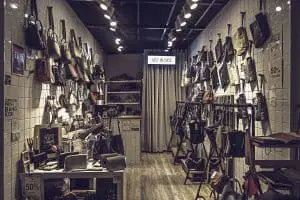Introduction
With today’s standards of profitability in the business world, companies often focus most of their resources on one thing: monetary gains. Even brands that begin as passion projects can be blinded by capitalistic measures of success. After all, here in America, many individuals live according to the motto, “if you’re good at something, never do it for free”.
Brands that have this sort of mindset will often overlook or disregard the impact they might have on the environment, society, or traditional cultures. While you might first think of fast fashion brands like Zara or H&M when you think of companies that are profit-driven first and cause-driven second, you will probably be surprised to hear that luxury brands like Dior and Saint Laurent are also willing to cut corners when it comes to cheap production.
Luxury brands (like the ones mentioned, as well as brands under parent companies Kering, and fashion houses such as Burberry) manufacture their products in sweatshops and factories in places like Mumbai, where they can get away with paying the seamstresses that hand embroiders their products just dollars a week. Some of the aforementioned luxury brands have signed something called the Utthan Pact with the goal to provide adequate working conditions in thirds world countries. However, this pact does little to hold brands accountable, and little progress has been shown in this area.
The high prices of luxury merchandise give the illusion that high-end brands are somehow better than the average fashion company in terms of production means, when in fact, they are more similar than you would think. When asked by the New York Times for a statement in an investigative piece on the topic, luxury brand LVMH denied any comment about the matter.
In recent years, however, brands have emerged that go against the grain of putting profitability as their first priority – these brands follow a business model called impact first.
Before we dive into the topic of impact first business models, here’s a breakdown of the topics we are going to discuss today.
- What is an impact first business model?
- Angel Chang the Designer
- ANGEL CHANG the Brand
- Short-Term vs. Long Term Implications of Angel Chang’s Business Model
- Conclusions
1. What is an Impact First Business Model?
An impact first business model is when a company’s main focus is on the causal impact its brand has. Brands that follow this model pursue profit-making second and put working towards a greater cause at the forefront of its pursuits. This might even mean taking a loss in the first years of the company.
This is not to say that impact first brands do not care about generating a profit. Instead, companies that follow impact-first just do not cut corners when it comes to cheaper and easier production means. By prioritizing quality instead of quantity and using slower or more expensive production means, the short-term impact may be more expensive, but worth it in the long run for a company to build consumer loyalty with those who identify with the impact a brand is trying to make with their products. Once this brand loyalty is built, it is nearly impossible for competitors to replicate the same impact.
Impact first is all about striking a balance between profit and purpose in your business model. This business model goes beyond what many fashion brands do today to appear cause-oriented, like simply releasing a statement about a cause to show support or using marketing tactics with no evidence to support a cause-driven stance. Instead, impact first brands center the foundation of their companies around a cause. By doing so, impact first brands go beyond just surface-level fixes or marketing tactics, instead, they address issues at an operational level in their brand.
Examples might be companies that go out of their way to only use sustainably sourced raw materials, a brand that invests an extended size line to appeal to all body types, or a business that gives a (sizeable) amount of proceeds to a charity with each purchase.
If there’s one brand that seemingly has an impact first business model down, it’s Angel Chang. Angel Chang is a zero-carbon womenswear line produced in the villages of southwest China by indigenous artisans. But, Angel Chang herself did not create this line out of thin air. It has taken about 2000 years for this line to come to fruition.
2. Angel Chang the Designer
Born and raised in Indiana, Angel Chang grew up as a first-generation American from Chinese descent. She attended college in New York City where she interned with fashion designer Anna Sui and graduated from Barnard College with a degree in Art History and Visual Arts. In the few years after receiving her bachelor’s degree, Chang received her Master’s in Modern Art from Columbia University.
Angel Chang took her knowledge of art and applied it to her first designing positions at Donna Karan Collection in NYC and Chloé in Paris. Not long after in 2006, Chang created her first eponymous label that incorporated innovative technologies in her womenswear line. Her pieces included light-up fabrics, color-changing designs, and self-heated linings.
However, after creating this line, Angel felt as though innovative technology was not the future of fashion, as one might think, but instead the opposite was to be true. So, in 2011, Chang moved from her NYC apartment to a mountain village in the Guizhou Province of rural China—one of the poorest regions in the country. Here, she looked to the past to learn the traditions of her ancestors to learn ancient textile-producing techniques for her line.
In 2016, Angel Chang became a TED Resident, speaking to a global audience, warning about the unsustainability of the fashion industry, and encouraging consumers to invest in a few pieces of high-quality clothing as opposed to many pieces of lower quality clothing. She is also a Smithsonian Artist, and has been featured in countless publications from around the world for her dedication to sustainability and preserving traditional fabric production techniques.
3. ANGEL CHANG the Brand
According to the ANGEL CHANG website, the brand encourages three main goals in its mission: Support women artisans, wear organic natural fibers, and buy only what you love. These three issues are addressed on the basis of the entire brand.
As we previously mentioned, the womenswear line is produced entirely by villagers in the Guizhou Province of China by women artisans that share ancestral background with Angel Chang herself. By producing the line completely vertically, “from seed to button”, as Chang puts it, she has the ability to ensure that cultural traditions are being honored, and the brand’s carbon footprint remains at a minimum. These goals are ensured with six pillars of social responsibility that the brand strives to maintain, as mentioned on its website.
- Preserving Traditional Culture: In the past few decades, China has become increasingly technologically advanced. However, this comes at the cost of rich family traditions and cultural practices. The small villages of the Guizhou Province have produced textiles for clothing for thousands of years out of necessity, not generating any profit. But, with the recent and quick modernization of China, over the last 30 years specifically, people are moving from their families’ small villages to more populated areas. With this migration of people, culture is often being lost in the process. Newer generations that leave the villages are not adopting the knowledge of textile making that their grandmothers are hoping to pass down. Angel Chang states on her website that while it is important to support progress and modernization in rural China, “it need not come at the sacrifice of their own culture.”
- Fabric as Culture: Chang explains that fabric making is so much more to ethnic minority villages in Guizhou than just a bonding experience or even for clothing items—cultures such as these historically did not have a written language. The patterns in their fabrics were used “to orally convey the story of their people”, as she puts it. The technique of fabric dying used by ethnic minorities in Guizhou has been practiced for over 2000 years. The dye and weaving methods are passed down from generation to generation, and when one receives a piece of clothing made from the fabric, it is considered “a gift of love for the recipient and an heirloom to pass down” in the culture of their origins.
- Rural Employment: The migration of younger generations to more technologically advanced cities is fueled by the lack of work in the small villages they are from. The dyeing and weaving techniques used by the cultures take years to learn in order to perfect the craft. And, once it is learned, it is usually not a source of profit for the family. Accompanying the lack of profit is the lack of health care and education that the villages cannot promise. Because of these factors, working-aged people are moving to more populated areas and are willing to risk working in sweatshops in order to make any sort of income to provide for their families.
- Environmental Sustainability: It is commonly known that the fashion industry is the second largest polluter in the world. According to The World Bank, as cited on Chang’s website, “20% of industrial water pollution comes from textile dyeing and treatment”. Not only can chemically made and treated clothes be harmful to the environment, but they can be harmful to the people wearing them as well. Chemicals from the clothing can be absorbed into the skin or evaporated into the air. On the other hand, the textiles created by the indigenous people of Guizhou are derived completely from nature and are not harmful in any way to the people that interact with them. (Angel goes into more depth on the topic in her TED Talk, “How Ancient Textiles Can Help the Future”).
- Family Values: Those workers that are forced to fall subject to the income of sweatshops and manufacturing plants are often young parents. Children in this situation will often stay behind in the villages, only to see their parents once a year when they are able to travel back home. Chinese values are built around the foundation of a family, which is difficult to uphold with parents that cannot see their children more than a few days out of the year. If more job opportunities presented themselves in the countryside, parents might not be forced to leave their children behind in the pursuit of work.
- Inspire the Younger Generation: The emerging generation in China makes up about 20% of the country’s total population. Chang is weary of what it might look like to raise a generation without the strong family values that the indigenous tribes are built around. Not only is it concerning that a generation is subject to growing up without their parents present, but the cultures are also at risk of losing their heritage if younger generations are not willing to learn the ancient textile techniques that are traditionally passed down from mother to daughter in each family.
4. Short-Term vs. Long Term Implications of Angel Chang’s Business Model
If you take a look at the products being sold on the ANGEL CHANG website, the cheapest item (Chang’s take on a t-shirt) goes for $440, the most expensive item, a dress, sells for $1220. Not to mention, in today’s world where consumers want the latest look as soon as it drops, Chang asks for shoppers to allow for 4-6 weeks to receive each order, as most garments are made to order.
In the short-term, Chang may face criticism or lack of interest from those shoppers who want their clothes as soon as possible. It may take time to build a loyal consumer base in the luxury world while trying to encourage the shopping pattern of buying a few, more expensive staple items opposed to cheaper and trendier pieces.
However, in the long term, ANGEL CHANG’s business model will resonate with those who identify with Chinese cultures themselves, or those that can appreciate the intricacy of the fabric-making process. Not only is the brand preserving traditional culture, but it is also building a sustainable model in which no electricity is used in the manufacturing process. Artisans are paid a living wage, each resource is obtained from a 30-mile radius of the village, and the clothes that are produced at such a high quality that they will last a lifetime.
5. Conclusions
Impact first brands are going beyond just implementing Corporate Social Responsibility policies. Instead, they are addressing an issue at the operational level of their business in order to build elevated brand loyalty from their consumers. In this case study, we focused on designer Angel Chang, whose eponymous label is produced with zero carbon footprint by indigenous artisans from the Guizhou Province of China. While it may take a longer time than average for the brand to gain traction in the fashion world due to its long lead time and high prices, the company will, in the long run, create an impact by preserving ancient cultural traditions and proving that luxury fashion can be sustainable.







